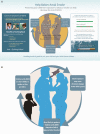Informing women about the risks of exposing babies to tobacco smoke: outreach and education efforts using Facebook "boost posts"
- PMID: 35532323
- PMCID: PMC9154290
- DOI: 10.1093/tbm/ibab158
Informing women about the risks of exposing babies to tobacco smoke: outreach and education efforts using Facebook "boost posts"
Abstract
Maternal smoking is associated with a host of negative health outcomes, including an increased risk of children developing attention-deficit/hyperactivity disorder (ADHD). This study evaluated the efficacy of health messages disseminated through Facebook Ads focused on reducing tobacco smoke exposure during pregnancy. Two message versions were promoted via post advertisements on Facebook-a static infographic and a video containing an animated version of the infographic. The reach of and engagement with each message version was evaluated. Comments made to the posts were assessed using content analysis. The infographic reached approximately 60,000 people and the video reached about 16,000 people. The average costs were $10.00 and $40.00 per 1,000 people reached for the infographic- and video-based posts, respectively. While there was no engagement with the video, the infographic was liked (n = 157), given alternative likes (n = 59), shared (n = 171 to 341), and commented on (n = 221). About one-quarter of comments contained a personal narrative and mentions of health history related to ADHD and/or smoking. Comments were more often negative (than positive) (16.6% vs 3.9%) and expressed skepticism more often than message acceptance (21.5% vs 12.2%). Facebook users were more responsive to the infographic (compared to the video) and static posts were a preferred channel (i.e., higher engagement at a lower cost) to disseminate messages when using the boost post feature on Facebook for health education. Our review of the comments provided insights into message acceptance and guidance for future social media-based health message campaigns. However, it is not known whether and if so, how, these findings on message exposure would correlate with behavioral intentions or changes in behavior, such as intentions to quit smoking or smoking cessation.
Keywords: ADHD; Maternal smoking; Message campaign; Social media.
© Society of Behavioral Medicine 2022. All rights reserved. For permissions, please e-mail: journals.permissions@oup.com.
Figures
Similar articles
-
Social Media Data Mining of Antitobacco Campaign Messages: Machine Learning Analysis of Facebook Posts.J Med Internet Res. 2023 Feb 13;25:e42863. doi: 10.2196/42863. J Med Internet Res. 2023. PMID: 36780224 Free PMC article.
-
Harnessing Facebook for Smoking Reduction and Cessation Interventions: Facebook User Engagement and Social Support Predict Smoking Reduction.J Med Internet Res. 2017 May 23;19(5):e168. doi: 10.2196/jmir.6681. J Med Internet Res. 2017. PMID: 28536096 Free PMC article.
-
The role of Facebook in Crush the Crave, a mobile- and social media-based smoking cessation intervention: qualitative framework analysis of posts.J Med Internet Res. 2014 Jul 11;16(7):e170. doi: 10.2196/jmir.3189. J Med Internet Res. 2014. PMID: 25016998 Free PMC article.
-
The Economic Impact of Smoking and of Reducing Smoking Prevalence: Review of Evidence.Tob Use Insights. 2015 Jul 14;8:1-35. doi: 10.4137/TUI.S15628. eCollection 2015. Tob Use Insights. 2015. PMID: 26242225 Free PMC article. Review.
-
Exposure to Tobacco, Environmental Tobacco Smoke and Nicotine in Pregnancy: A Pragmatic Overview of Reviews of Maternal and Child Outcomes, Effectiveness of Interventions and Barriers and Facilitators to Quitting.Int J Environ Res Public Health. 2020 Mar 19;17(6):2034. doi: 10.3390/ijerph17062034. Int J Environ Res Public Health. 2020. PMID: 32204415 Free PMC article. Review.
Cited by
-
Evaluating Messaging on Prenatal Health Behaviors Using Social Media Data: Systematic Review.J Med Internet Res. 2023 Dec 20;25:e44912. doi: 10.2196/44912. J Med Internet Res. 2023. PMID: 38117557 Free PMC article.
-
Exploring Social Media Posts on Lifestyle Behaviors: Sentiment and Content Analysis.JMIR Infodemiology. 2025 Jun 25;5:e65835. doi: 10.2196/65835. JMIR Infodemiology. 2025. PMID: 40561482 Free PMC article.
-
A Model of Social Media Effects in Public Health Communication Campaigns: Systematic Review.J Med Internet Res. 2023 Jul 14;25:e46345. doi: 10.2196/46345. J Med Internet Res. 2023. PMID: 37450325 Free PMC article.
-
Elements Influencing User Engagement in Social Media Posts on Lifestyle Risk Factors: Systematic Review.J Med Internet Res. 2024 Nov 22;26:e59742. doi: 10.2196/59742. J Med Internet Res. 2024. PMID: 39576982 Free PMC article.
References
-
- National Center for Chronic Disease Prevention and Health Promotion. Prevalence of selected maternal and child health indicators for all PRAMS sites, Pregnancy Risk Assessment Monitoring System (PRAMS). 2018. Available at https://www.cdc.gov/prams/prams-data/mch-indicators/states/pdf/2018/All-.... Accessibility verified April 10, 2020.
-
- Driga AM, Drigas A. ADHD in the early years: Pre-natal and early causes and alternative ways of dealing. Int J Online Biomed Eng (iJOE). 2019;15(13):95–102.
Publication types
MeSH terms
Substances
Grants and funding
LinkOut - more resources
Full Text Sources
Medical


